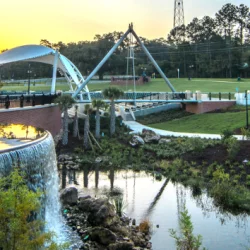The Sturdiest Trees In NC
North Carolina is a Southeastern state with hot, humid summers and cold winters. It is a perfect destination due to the natural beauty it offers. The state is best known for the Appalachian Mountains, Great Smoky Mountains, Blue Ridge Mountains, and Cape Hatteras. The state has a diverse environment, home to several species of wildlife and vegetation. The natural beauty of the coastal plains attracts thousands of visitors every year. The state's temperate climate is ideal for developing various plant species. The average annual rainfall is about 48 inches. This contributes to its good farming conditions.
But the fact remains that even the most beautiful scenes in nature are susceptible to harsh weather conditions. As such, falling trees accounted for 407 deaths between 1995 and 2007 in the US. With that in mind, keeping the right kinds of trees and plants around your home is essential for your family’s safety. If you’re looking for some beautiful and safe foliage to spruce up your yard, we’ve got a list of the sturdiest trees that will survive the many seasons in NC.
1. Maple Trees
Maple trees can live for over a hundred years and grow up to 150 feet tall. They require little maintenance and do not require a lot of space. They can tolerate varying weather conditions and low light levels, making them suitable for urban areas. Due to their sturdiness, they are often used as a shade or specimen tree. The leaves of the trees turn red in autumn and provide aesthetic beauty to the surroundings. After planting, the trees will take 10 to 20 years to reach the desired size. They can tolerate temperature swings and can survive in cool temperatures as well.
2. White Oak
Oak trees are perennial hardwood trees that can survive through very harsh weather conditions. They have sturdy branches and wide-spreading roots that help them to cope with strong winds and heavy snowfall. The White Oak is incredibly resistant to diseases and pests. The tree may start producing acorns after six years of planting. They grow in parks and gardens for their beauty. They have red leaves in the fall and can live up to 250 years.
3. Shagbark Hickory
This tree has a unique bark which creates a shaggy appearance. It is resistant to pests and diseases. It maintains its beauty for long periods. The tree's wood is highly valued for its strength and flexibility, making it the ideal choice for construction. They can grow up to 80 feet tall and 40 inches in width. It can live up to 2 centuries, but some might last even longer under proper conditions. The leaves turn red in autumn and provide a picturesque landscape. The tree is suitable for planting on streets and parking lots.
4. Leyland Cypress
Due to its strong nature, people use this cypress as a windbreak or barrier. The trees can live as long as 80 years and reach heights of up to 50 feet after ten years of planting. They are often used for landscaping purposes in front yards. The coniferous evergreen tree can tolerate a wide range of temperatures. Maintenance involves removing dead twigs and pruning the branches regularly. Failure to keep up with regular care can make removing them in an emergency quite difficult to handle alone.
5. Black Gum
The tree grows up to 60 feet tall. It is resistant to pests and diseases and requires very little maintenance. Remove overgrown branches regularly, and the roots should be trimmed. The tree has a beautiful white spring flower, attracting bees and other pollinating insects. It blooms in May or June. The leaves start growing and begin to shed in October or November. Avoid planting this tree in urban areas because it spreads aggressively. It thrives mainly in the countryside.
6. Green Hawthorn
These trees are usually planted in large groups to make a hedge. They are also used as a specimen trees. They require little maintenance and can tolerate extreme weather conditions. The leaves turn red in the autumn and provide beautiful colors to the environment. The aesthetic appeal of the tree makes it a favorite among property owners. They need regular watering and should not be allowed to dry out. To get the maximum aesthetic effect, tri the trees regularly.
7. Fringe Tree
The Fringe tree is a native of North Carolina and can survive severe weather conditions. The single, crooked trunk is the most noticeable trait of this tree. It has a height of up to 60 feet and can live for over a hundred years. The white flowers provide an aesthetic appearance in spring. The leaves turn red in autumn, which gives them an excellent impression. It is suitable for planting in gardens and parks but not recommended for planting in a residential area. Its appearance will attract a lot of attention from birds.
8. Dogwoods
Dogwood is one of the most beautiful trees in North Carolina. The flowers can be pink, red, or white and bloom during spring. The tree grows best in a humid environment and requires very little maintenance. It reaches a maximum height of 30 feet. Due to its beautiful appearance, people often plant in residential areas. The flowers attract a large number of bees which help in pollinating the tree. The tree also acts as a food source for many birds and insects. Expert recommend trimming to keep the tree at its desired height.
9. White Willow
The Willow tree is a European introduction widely planted in parks and gardens. It reaches a maximum height of 40 feet and requires very little maintenance. It grows best in moist soil and requires ample water during summer. The leaves turn yellow in autumn, providing aesthetic beauty to the surrounding environment. The branches are flexible, making them suitable for planting near roads, houses, or other buildings. Do not plant them in areas prone to heavy winds or storms because of their low-hanging branches. Experts recommend pruning them to keep it at the desired size. The tree also attracts many birds who build their nests in the sturdy branches.
There are many other varieties and types of trees that are equally as beautiful and appealing. To boost the beauty of your surroundings, variety will do the trick. Choose trees with the most suitable features for your property or desired location. Consult a professional landscaper to help you select the trees best suited for your budget, space, and climate.
More to Read:
Previous Posts:




